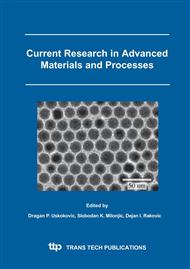p.211
p.217
p.223
p.229
p.235
p.241
p.247
p.253
p.259
Morphology and Capacitive Properties of [RuOxHy/Low Surface Area Carbon Black] Composite Materials Prepared by Sol Gel Procedure
Abstract:
The morphology and the capacitive properties of carbon supported hydrous ruthenium oxide (RuOxHy/C), prepared by impregnation of low-surface area carbon black VulcanÒ XC-72 R with solid phase of RuOxHy sol, were investigated by scanning electron microscopy, cyclic voltammetry and electrochemical impedance spectroscopy. The oxide sols of different ageing times, prepared by forced hydrolysis of RuCl3, were used for composite preparation. The prepared composites show considerably higher capacitance values in acid electrolyte if compared to carbon black support. Microscopic investigations show that the extent of impregnation and the composite surface appearance depend on ageing time. The composite capacitance increases with ageing time of oxide sol. A gradual decrease in capacitance of thermally untreated composite with charging/discharging cycles was registered, which appears to be related to the extent of impregnation, too. Electrochemical impedance spectroscopy measurements indicate an in-depth capacitance distribution through the composite layer. It was found that NafionÒ layer, used to ensure the adhesion of the composite layer to the current collector, influenced the composite impedance behavior, especially on the oxide-rich parts of the composite surface.
Info:
Periodical:
Pages:
235-240
Citation:
Online since:
September 2005
Price:
Сopyright:
© 2005 Trans Tech Publications Ltd. All Rights Reserved
Share:
Citation:


